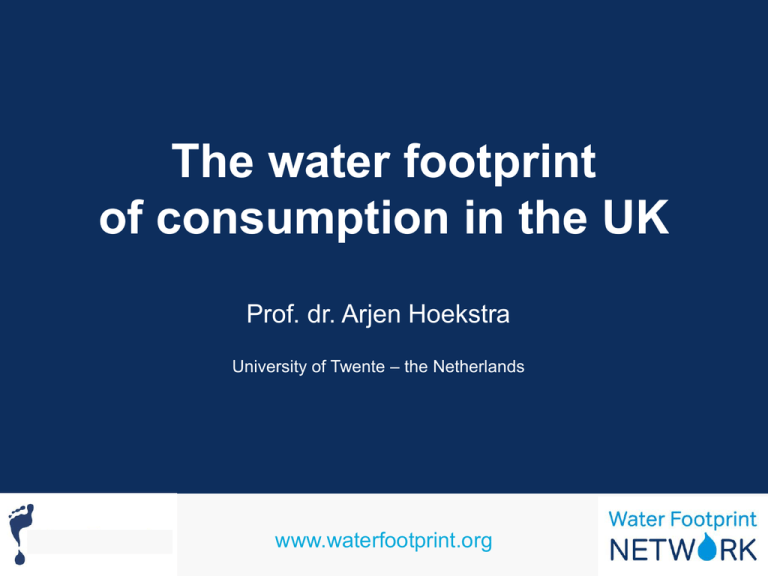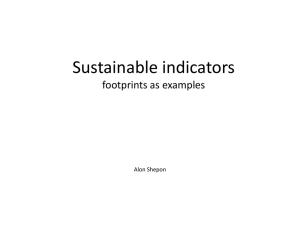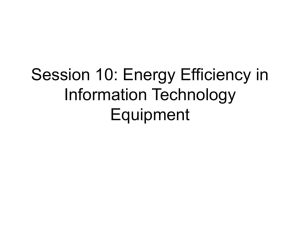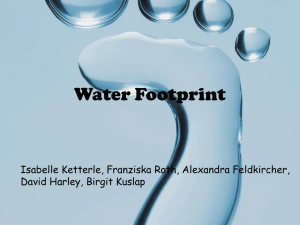Professor Arjen Y. Hoekstra powerpoint
advertisement

The water footprint of consumption in the UK Prof. dr. Arjen Hoekstra University of Twente – the Netherlands www.waterfootprint.org Overview - Freshwater scarcity & pollution - The water footprint of - our daily commodities - meat - bio-energy - What can we do? Signs of global water scarcity Strawberries for export Coto Doñana National Park, southern Spain Signs of global water scarcity Cotton for export Former Aral Sea, Central Asia Signs of global water scarcity Soybeans, deforestation, Mato Grosso, Brazil It takes 1430 million m3 of water per year to produce soybean in Brazil for export to the UK. (equiv. to more than 0.5 million Olympic swimming pools) Signs of global water pollution The total water footprint of a consumer in the UK ► about 3% of your water footprint is at home. 150 litre/day ► about 97% of your water footprint is ‘invisible’, it is related to the products you buy in the supermarket. 3400 litre/day for agricultural products 1100 litre/day for industrial products ► about 60 to 65% of your water footprint lies abroad. The water footprint of a product Green water footprint ► volume of rainwater evaporated. Blue water footprint ► volume of surface or groundwater evaporated. Grey water footprint ► volume of polluted water. Global water footprint of UK consumption 62% of the UK water footprint is outside its own borders [Chapagain & Orr, 2008] [Hoekstra & Chapagain, 2008] [Hoekstra & Chapagain, 2008] [Hoekstra & Chapagain, 2008] 99% of the total refers to water consumed in producing the feed [Hoekstra & Chapagain, 2008] [Hoekstra & Chapagain, 2008] [Hoekstra & Chapagain, 2008] Meat versus vegetarian diet Meat diet Industrial countries Developing countries kcal/day litre/kcal litre/day Animal origin 950 2.5 2375 Vegetable origin 2450 0.5 Total 3400 Animal origin 350 Vegetable origin 2350 Total 2700 Vegetarian diet kcal/day litre/kcal litre/day Animal origin 300 2.5 750 1225 Vegetable origin 3100 0.5 1550 3600 Total 3400 2.5 875 Animal origin 200 2.5 500 0.5 1175 Vegetable origin 2500 0.5 1250 2050 Total 2700 2300 1750 Meat versus vegetarian diet Meat diet Industrial countries Developing countries kcal/day litre/kcal litre/day Animal origin 950 2.5 2375 Vegetable origin 2450 0.5 Total 3400 Animal origin 350 Vegetable origin 2350 Total 2700 Vegetarian diet kcal/day litre/kcal litre/day Animal origin 300 2.5 750 1225 Vegetable origin 3100 0.5 1550 3600 Total 3400 2.5 875 Animal origin 200 2.5 500 0.5 1175 Vegetable origin 2500 0.5 1250 2050 Total 2700 2300 1750 Meat versus vegetarian diet Meat diet Industrial countries Developing countries kcal/day litre/kcal litre/day Animal origin 950 2.5 2375 Vegetable origin 2450 0.5 Total 3400 Animal origin 350 Vegetable origin 2350 Total 2700 Vegetarian diet kcal/day litre/kcal litre/day Animal origin 300 2.5 750 1225 Vegetable origin 3100 0.5 1550 3600 Total 3400 2.5 875 Animal origin 200 2.5 500 0.5 1175 Vegetable origin 2500 0.5 1250 2050 Total 2700 2300 1750 Grazing systems Water footprint: • mostly green • local Water footprint: • green & blue • local Mixed systems Water footprint: • green & blue • partly imported Industrial systems Water footprint of biofuels from different crops [litre/litre] [Gerbens-Leenes, Hoekstra & Van der Meer, 2009] Water footprint of transport when fueled with bio-energy Transport mode Energy source Crop source WF (litre per passenger km) Biodiesel Rapeseed 236-492 Bio-ethanol Sugar beet 65-136 Biodiesel Rapeseed 109-355 Bio-ethanol Sugar beet 36-212 Biodiesel Rapeseed 111-154 Bio-ethanol Sugar beet 31-43 Train Bio-electricity Maize 8-19 Electric car Bio-electricity Maize 11-13 Walking Sugar Sugar beet 4.4 Bike Sugar Sugar beet 1.7 Airplane Car Bus What can we do? Reducing humanity’s water footprint – Companies • Shared terminology & calculation standards • Product transparency • Benchmarking • Quantitative footprint reduction targets • for both own operations and supply chain Global standard Feb. 2011 Reducing humanity’s water footprint – Government • Embed water footprint assessment in national water policy making. • Promote coherence between water and other governmental policies: environmental, agricultural, energy, trade, foreign policy. • Reduce the own organizational water footprint • Promote product transparency Stop waste of ‘blue water’ Full water recycling in industries Towards precision irrigation Make better use of ‘green water’ Increase water productivity in rain-fed agriculture Grey water footprint zero Towards organic farming Towards zero emission








